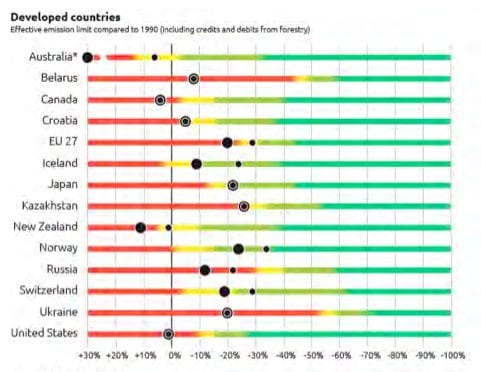Australia’s mainstream politicians – both Labor and conservative – claim that their bipartisan emission reduction target of 5 per cent by 2020 puts the country in line with international action.
Some even claim it puts us ahead, or that we are the only ones in the world taking any action. “Australia acting by itself is not going to make any difference whatsoever,” Barnaby Joyce, federal agriculture minister and future acting prime minister, told the ABC TV program Q&A on Monday night.
But a new assessment dismisses this as nonsense, suggesting that Australia lies among the ranks of international cellar dwellers on climate action. Even a 25 per cent reduction would rank the country as “barely adequate” in terms of the 2°C cap in average global temperature rises that the country has signed up to.
“The level of ambition of 5 per cent is, to say the least, at the bottom of the spectrum,” Bill Hare, the CEO of Berlin-based Climate Analytics, told RenewEconomy in an interview on Monday. “A 25 per cent emissions reduction target would put Australia on the borderline between satisfactory and barely sufficient.”
The table, published at the end of this story, highlights the situation. Stripping out the highly contentious allowances for land use change, Australia’s emissions will be 32 per cent above business as usual in 2020, with only India and Moldova producing worst results.
Australia’s 5 per cent reduction target also puts it firmly into the “red zone” of inadequacy, along with former Soviet bloc nations such as Russia, Ukraine, Belarus and Kazakhstan, as well as Canada.
These are the countries with which Australia is now being compared, and the assumption that Australia is somehow at the forefront of climate action is considered fanciful.
Indeed, Hare says that there is complete bewilderment among international policy makers as to why Australia should choose to repeal its carbon price, considering the new UNFCCC assessment report, the moves towards a global agreement in Paris in 2015, and the country’s exposure to climate change.
“The countries I have spoken to at high level officials and ministers in recent weeks don’t really understand what’s going on,” he said. “They see reference to the carbon being tax taken away, they cannot believe it applies to a carbon price and the whole legislative instruments being taken away.
“The debate is more sophisticated elsewhere, because there is a recognition that you cannot run away from a carbon price. There is recognition that the command and control mechanisms (of direct action) are deeply inefficient.”
Hare says the process for a new treaty will accelerate in 2014, particularly around September when UN secretary-general Ban ki-Moon will hold a summit of leaders to get them to commit to high levels of ambition.
But Hare says there are already strong signs of progress. China, to combat its devastating levels of pollution, something that has reared its head again this week, and the US, with its demanding emissions standards, are moving to curb coal consumption. China is moving towards an emissions trading scheme, and the US administration wishes it could.
Hare says that the climate legislation adopted by the previous government established a “first class” government machinery for the covered sectors, to put in place standards, policies, and to fund the development of clean energy and energy efficiency.
But while the “machinery” earned the government high marks, the target did not. “It is not an unremittingly bleak story. The Climate Change Authority report (on caps and targets) will be out soon. The new government will need to look at it seriously.”
The big black dots represent the currently pledged emissions of the country, and the small black circles the high reduction pledge. The red zone indicated inadequate emissions targets to meet the global 2°C ambition, the yellow zone represents the “least stringent” part of the 2°C range, the green zone represents sufficient pledge for the more stringent part of the 2°C range, and the green zone is the “role model” area where targets are more ambitious than the 2°C target.











